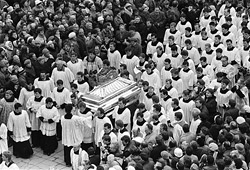Piety
The tomb of St Casimir has always been a major attraction for pilgrims, beginning already when his remains rested in the Royal (now “Valavičius Family”) Chapel. A document dated May 15, 1501, with which Pope Alexander VI (1492-1503) granted a plenary indulgence to pilgrims who visited this chapel, noted also the tomb of Casimir, to which it said miracles were attributed. The earliest documents regarding the cult of St Casimir indicate that his tomb extraordinarily rapidly became a place of special graces. Already in 1513, the holy man’s coffin was covered with a large number of wax and silver votive offerings.
Evidence of reputed special graces can also be found in the painting, known as “The Three-handed Casimir”, which hangs above the tabernacle in the current Chapel of St Casimir. The image, made in the mid 16th century based on an older artwork, depicts the saint with three hands: two right hands hold a lily. Legend has it that the artist was not happy with the outstretched arm holding a lily that he first painted, and so redid it. But the original arm became visible once again and proved impossible to paint over. In any case, the symbolic value of this depiction is probably linked with St Casimir’s exceptional generosity or with special graces received through his intercession. The right hand, which appears twice in this painting, has the meaning of “justice” or “generosity” in biblical tradition. The miraculous “three-handedness” thus most likely stresses the power of St Casimir’s intercession to win special graces. Already in the 17th century, this icon of St Casimir was listed among the Cathedral’s treasures. Some 200 votive offerings on the black marble columns of the altarpiece reflect the extraordinary graces that people receive through St Casimir’s intercession even today.
Every March 4, the feast day of St Casimir, a Mass for families is celebrated in his honour at noon in Vilnius Cathedral. In the evening, young people congregate in the cathedral to pay tribute to the patron saint of Lithuania and of youth. They gather in prayer before St Casimir’s relics, attend special catechetical talks and praise God with youthful hymns for this great saint. The Metropolitan Archbishop of Vilnius presides over Holy Mass for the young people, youth organisations and the priests and religious involved in the pastoral care of young people. Then they spend a pleasant evening together, including a fraternal agape, in honour of St Casimir.
Mass is celebrated and hymns are sung in the Chapel of St Casimir, beside his relics, at 8 a.m. and 6:30 p.m. every day. Groups of pilgrims from many countries also celebrate Mass by St Casimir’s tomb in a variety of languages.
Many people receive the Sacrament of Baptism in the Chapel of St Casimir, while couples often come here to prayer before this saint’s relics just after receiving the Sacrament of Matrimony. Newly ordained priests kneel in prayer together with their bishop beside the remains of St Casimir, asking for perseverance and help in the path of service and celibacy.
In 2004, while marking the 520th anniversary of St Casimir’s death, his ornate silver sarcophagus was placed on solemn display before the central altar in Vilnius Cathedral. This made it possible for people not only to pray before his holy remains, but also to touch his coffin.
Another attraction in Vilnius Cathedral for pilgrims’ eyes and hearts is the 16th century Sapiega Madonna painting in the Goštautas Family Chapel. Votive offerings displayed on either side of the image are tokens of appreciation for prayers that have been heard and who special graces that have been received.
Candles constantly burn before the impressive Crucifix in the Chapel of Exiles. This forceful scene from Christ’s Passion helps believers prayerfully recall the national martyrs and bishops of Vilnius.








